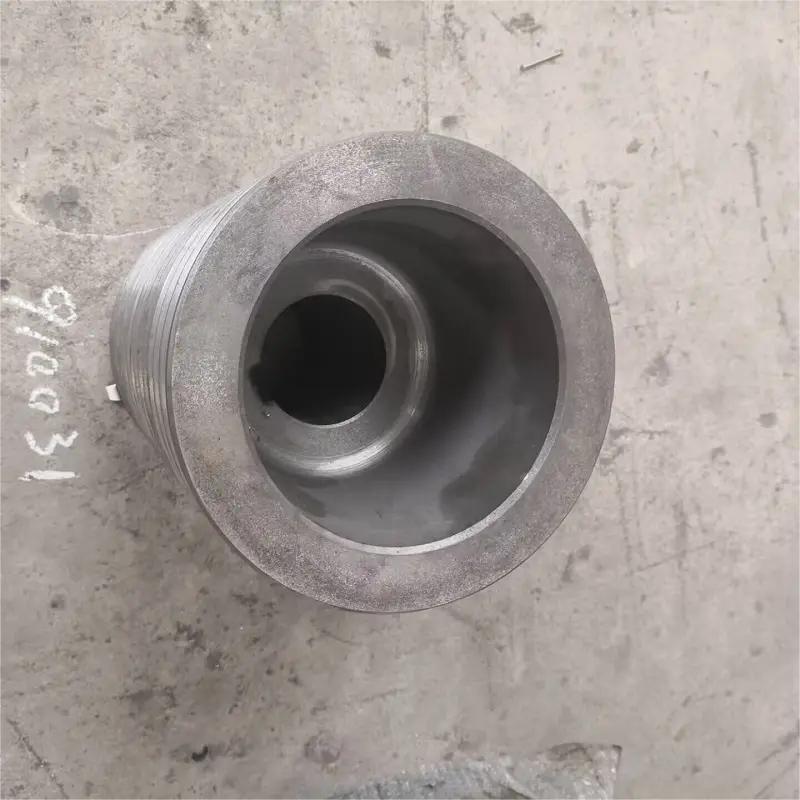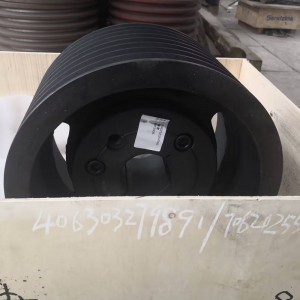In the operation of the crusher, the V-belt pulley plays a crucial role. It is not only responsible for transmitting the power of the motor to the main shaft of the crusher, but also ensures the stable operation of the entire transmission system. This article will provide a detailed introduction to the working principle, key points for selection, and maintenance methods of V-belt pulleys.
Working principle
The V-belt pulley is connected to the motor through the V-belt, converting the rotational power of the motor into the rotational power of the main shaft of the crusher. This transmission method is simple and efficient, and can ensure the smooth transmission of power. During operation, V-belts will undergo certain elastic deformation, which helps to buffer the impact and vibration during power transmission and protect the equipment from damage.
1.1 Power Transmission
The main function of the V-belt pulley is to transfer the power of the motor to the main shaft of the crusher. The motor drives the pulley to rotate through the V-belt, and the pulley then transmits power to the main shaft of the crusher through the shaft connection. This transmission method not only ensures the effective transmission of power but also can change the transmission ratio by adjusting the diameter of the pulley to meet different operational requirements.
1.2 Buffering Effect
During operation, V-belts will undergo certain elastic deformation, which helps to buffer the impact and vibration during the power transmission process. This elastic deformation can reduce the mechanical stress that the equipment experiences during operation and extend the service life of the equipment. Meanwhile, the elasticity of V-belts also helps to reduce noise and vibration during the transmission process, enhancing the operational stability of the equipment.
Select key points
Choosing the right V-belt pulley requires considering multiple factors. First of all, the size of the pulley should match the specifications of the motor and the crusher. Secondly, the material of the pulley is also very important. It is usually made of high-strength aluminum alloy or cast iron to ensure its durability and stability. In addition, the surface of the pulley should be smooth without burrs or cracks to reduce the wear of the V-belt.
2.1 Size Matching
The size of the pulley should match the specifications of the motor and the crusher. The diameter and width of the pulley should be selected based on the power and speed of the motor as well as the operational requirements of the crusher. If the pulley size is too small, it may cause the V-belt to slip, affecting the transmission efficiency. If the pulley size is too large, it will increase the volume and weight of the equipment and affect its flexibility.
2.2 Material Selection
The material of pulleys is usually high-strength aluminum alloy or cast iron. Aluminum alloy pulleys have the advantages of light weight, high strength and corrosion resistance, and are suitable for high-speed and light-load applications. Cast iron pulleys have higher strength and stability, and are suitable for heavy-load and low-speed applications. Choosing the appropriate material can ensure the durability and reliability of the pulley during long-term operation.
2.3 Surface Quality
The surface of the pulley should be smooth without burrs or cracks to reduce the wear of the V-belt. Pulleys with good surface quality can reduce the friction and wear of V-belts during operation and extend the service life of V-belts. Meanwhile, a smooth surface also helps to reduce noise and vibration during the transmission process, enhancing the operational stability of the equipment.
Maintenance and upkeep
Regular inspection of the condition of the V-belt pulley is the key to ensuring the normal operation of the crusher. Check if the pulley shows any signs of wear, deformation or looseness, and replace the severely worn pulley in time. At the same time, keep the pulley clean to prevent dust and debris from entering and affecting the transmission efficiency. Regularly adjust the tension of the V-belt to ensure that it does not slip or loosen during operation.
3.1 Regular Inspection
Regularly inspect the condition of the pulley, including whether there are signs of wear, deformation or loosening. If obvious wear or cracks are found on the surface of the pulley, it should be replaced in time. At the same time, check whether the fastening bolts of the pulley are loose to ensure that the pulley remains stable during operation.
3.2 Cleaning and Maintenance
Keep the pulley clean to prevent dust and debris from entering, which may affect the transmission efficiency. Regularly clean the dust and debris on the surface of the pulley to ensure that its surface is smooth. At the same time, check the surface of the V-belt for any wear or cracks. Replace the V-belt if necessary.
3.3 Tension adjustment
Regularly adjust the tension of the V-belt to ensure that it does not slip or loosen during operation. The tension of the V-belt should be moderate. If it is too tight, it will cause excessive wear of the V-belt and pulley. If it is too loose, it will cause the V-belt to slip, affecting the transmission efficiency. When adjusting the tension, special tools should be used to ensure that the adjusted tension meets the requirements.
The V-belt pulley plays a crucial role in the operation of the crusher. By understanding its working principle, key points for selection and maintenance methods, the stable operation of the transmission system of the crusher can be ensured, and the service life and operational efficiency of the equipment can be improved. Selecting the appropriate V-belt pulley and conducting regular maintenance not only enhances the performance of the crusher but also reduces the failure rate of the equipment, ensuring the smooth progress of the production process.
Post time: Jul-28-2025


